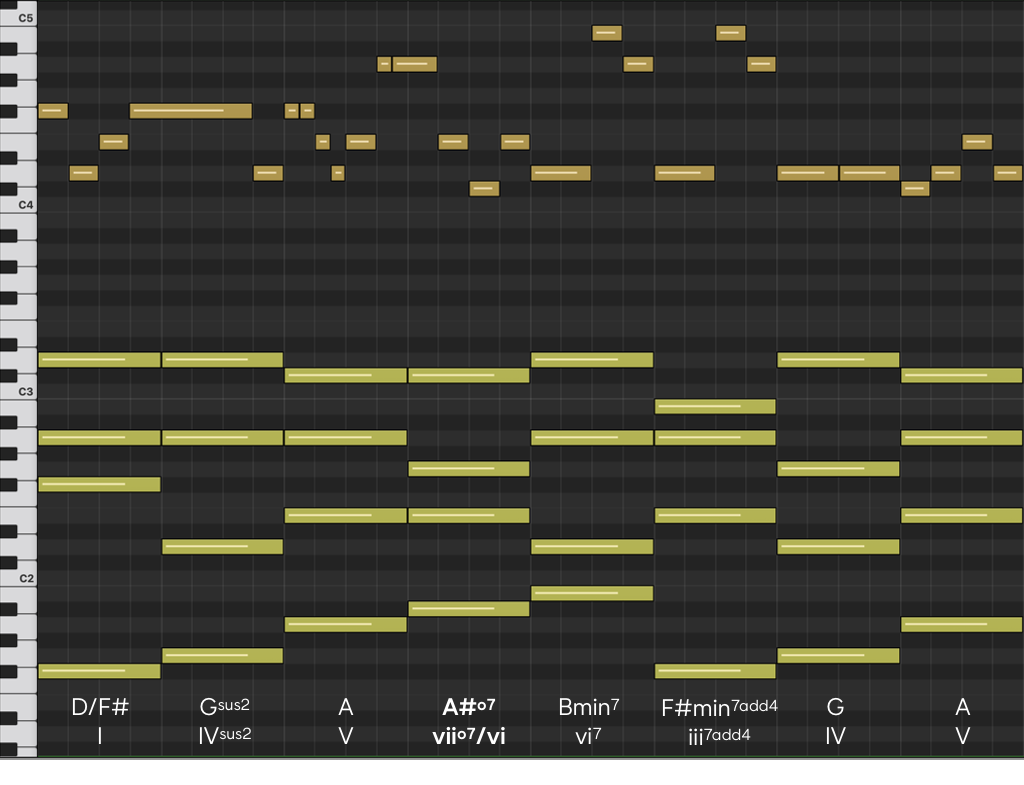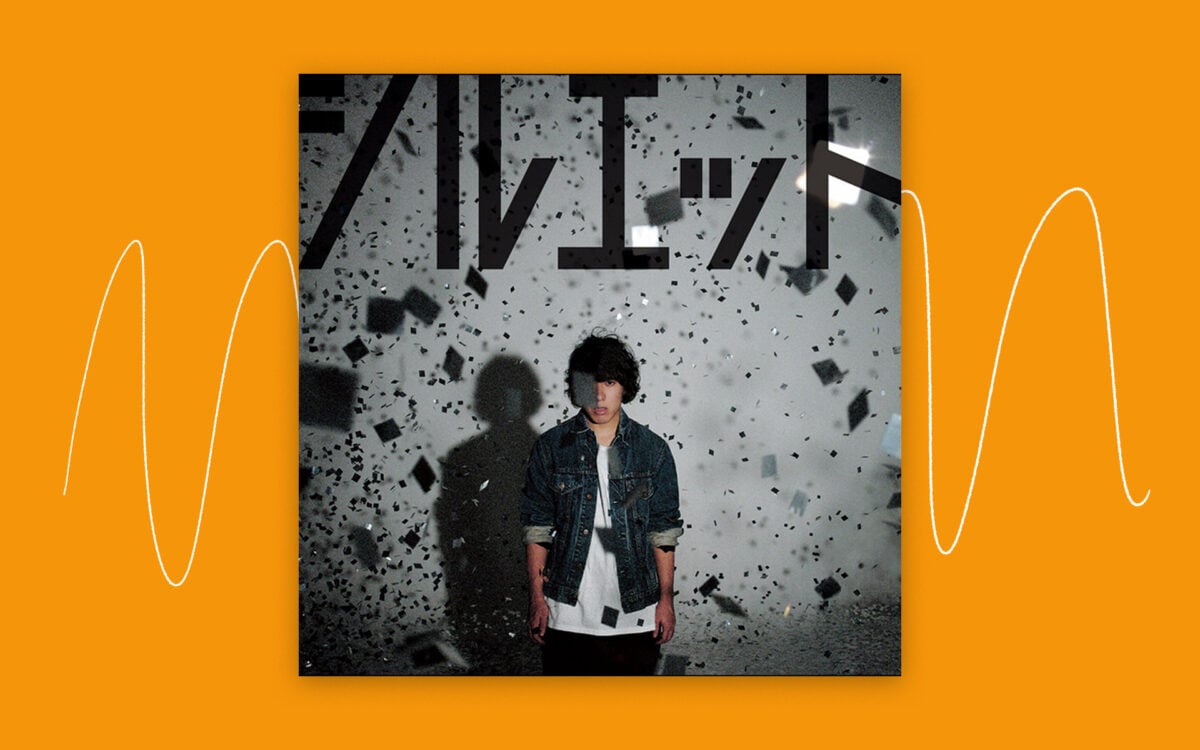It wouldn’t be an overstatement to say that KANA-BOON’s “Silhouette,” the sixteenth opening for Naruto Shippuden, is one of the most iconic OPs across the entirety of anime.
Scoring the series’ climax, “Silhouette” features a combination of infectious, universally-appealing melodies and an unapologetic dose of genuine emotion—a perfect match for the spirit of Naruto.
As you listen to the track, you’ll likely hear numerous interesting harmonic colors that add an unashamed emotiveness that’s just so indescribably distinct to the lexicons of J-pop and J-rock. In this article, we highlight a few of these chords in “Silhouette” that are specifically borrowed from outside of its home key (D major), and discuss how they fit into the larger composition and impact the music’s expressivity. MIDI screenshots transcribing the vocal melody and chord progression (with the chords we’re breaking down bolded) and audio excerpts are provided to help you see and hear exactly what’s going on.
Let’s dive in!
A satisfying dissonance

The first half of the verse of “Silhouette”
First things first—let’s acknowledge that almost all of these chords are cool in their own right. The suspensions, additions, sevenths, and inversions add interesting flavors to even the diatonic chords that are largely outlining simple I-IV-V-type moves. That said, all of the chords are exclusively using additional notes that belong right within the key of D major, except for one—the A#o7.
Although for just a fleeting moment, the A# in this chord adds an intensity that’s unique from the rest by serving as the leading tone to the subsequent Bmin7. The concept of this pitch might actually already feel pretty familiar to you; tons of songs across genres and geographies employ the III (or V/vi) chord, its more popular cousin that features the same leading tone as its third. Take a listen to the chord connecting the instrumental intro to the first verse of another popular Naruto Shippuden opening, Ikimonogakari’s “Blue Bird,” for an example of this color:
The chord occurring at 0:25 is a III7 chord, which also resolves nicely to the vi chord (also seen as a V7 – i cadence if we’re looking at the relative minor, which the song is centered around)
While serving the same function, the diminished seventh chord used in “Silhouette” is a slightly more niche substitution that adds some extra grit—both in how it positions the leading tone as the root of the chord, and in its inherently dissonant structure (featuring intervals like a ♭5). And of course, these less stable elements only combine to make the resolution even sweeter when it hits.
A unique passing chord

The second half of the verse of “Silhouette”
After the first eight bars of the verse play out, we begin looping back with both the same vocal melody and accompanying chords. This sets up the expectation that the chord progression is going to remain consistent throughout—after all, many of us are accustomed to ‘four-chord progressions’ that repeat the same handful of chords over and over for the entirety of a song’s section.
This is where we’re thrown our second surprise. The sixth chord in the progression, which was previously an F#min7add4, is replaced by a bold Cadd9. The latter may sound simpler in terms of its voicing, but what makes it so unexpected is that C♮ doesn’t naturally belong to the key of D major.
So what makes this chord feel surprising, but not totally random? There are a few things that make it work. For one, it’s far from the most foreign chord possible; the other pitches (E, G, and D) all fit nicely within our home key. Second, when we take a step back and look at the root movement across the greater progression, we see that the Cadd9 continues a chromatic ascent we’ve been on for the last three chords—this helps our ear make a little more sense of it when it hits. Lastly, the chord is followed up by a G major chord, and while we don’t tonicize it, Cadd9 could belong to the key of G major, which helps us ease our way out of it a bit.
This Cadd9 can be seen as what we loosely refer to as a passing chord—while it’s non-diatonic and kind of spicy, it fits snugly into the trajectory of the diatonic chords that both precede and follow it. This allows our ear to interpret it as a fleeting moment of cool harmonic color that adds a subtle but meaningful emotional contrast from the first half of the verse.
A steady chromatic descent

The pre-chorus of “Silhouette”
What’s better than one passing chord? An entire progression based on them! Traditional analysis tells us that the first few chords of the pre-chorus are quite complex, including the likes of a Bm/A# and a D♭5. However, it’s important to not overthink things; if you look closely, all that’s really going on here is a Bm triad repeated four times, with the root shifting down by a half step with each repetition. Eventually, this descending root lands nicely on the diatonic G major chord, which gets us back on track to set up for the chorus.
These sorts of chromatic descents are ubiquitous across popular Japanese music. For example, the chorus in Cö Shu Nie’s “asphyxia” (a track that served as an opening for Tokyo Ghoul:re) features similar passing chords that connect a Dm to a B♭maj7:
1:23 – 1:26 of the acoustic version of the track clearly highlights the chromaticism
While unrelated to Nagato’s powerful jutsu, songwriter and utaite Mafumafu’s track “Rinne Tensei” also features a series of descending chromatic chords at the end of its driving chorus:
Hear the chromatic hits at 1:12 – 1:15 that set up the end of the chorus
The bigger picture of “Silhouette”
So there you have it! While it may seem like we skipped over the focal point of the song (the chorus), we’ve actually already unlocked its harmonic secrets, since it simply reuses the progressions heard in the verse.
When thinking about incorporating these sorts of unique chords and progressions into your own music, it’s always important to not get ‘lost in the sauce.’ Remember to take a step back every now and then to ask yourself: Does this non-diatonic chord serve and help nuance the emotions I’m trying to convey? Or, does it actually distract from them? In the case of “Silhouette,” KANA-BOON always seems to prioritize emotional impact over all else, and that’s what makes the song so memorable.
Do you have any questions about any of the concepts we covered? What tracks would you like to see us analyze next? Start a conversation with us and an ever-growing community of other music creators via the Splice Discord.
Explore royalty-free melodies, chord progressions, and grooves by key, BPM, genre, and more:
May 20, 2024

.svg)
.svg)




